Tag: Video
-
Video: Flag woman confronts Israeli military at prisoner solidarity demonstration at Ofer
by Jessica Mansour 1 May 2012 | International Solidarity Movement, West Bank 4 people were injured today at a peaceful rally held near the Ofer military prison, in solidarity with hunger striking Palestinians within Israel’s Occupation prisons. Injuries sustained were caused by rubber coated steel bullets, along with tear gas canisters, skunk water, and pepper…
-
It’s time to harvest the crop: Accompanying farmers in Gaza under Israeli fire
by Rosa Schiano Translation by Claudia Saba 23 April 2012 | il Blog di Oliva Israeli soldiers have already started shooting onto the land along the border of the Gaza Strip. Two injured just in the first two days of the harvest. Renad Salem Qdeeh, 33, was collecting he crop from her land when Israeli…
-
Increasing Israeli army harassment and violence against activists in Hebron
by Paige 16 April 2012 | International Solidarity Movement, West Bank In the past weeks the Israeli army has increased harassment against both Palestinian and ISM activists in Hebron (Al Khalil), a deliberate targeting of those who oppose Israeli occupation and colonization. This targeting includes the arrest of six international activists, including five ISM volunteers,…


